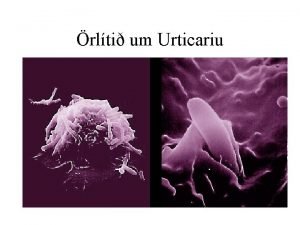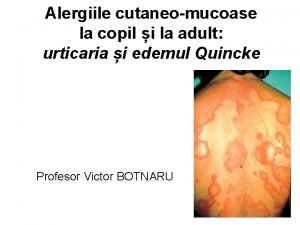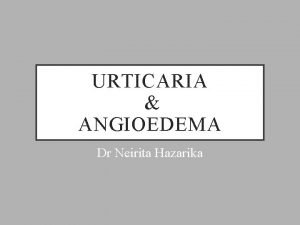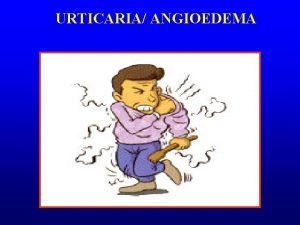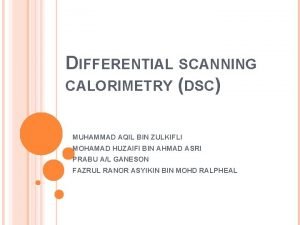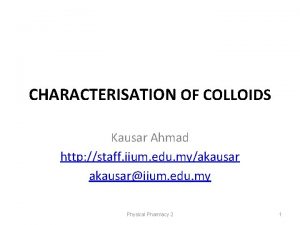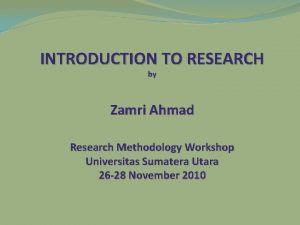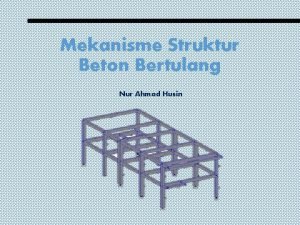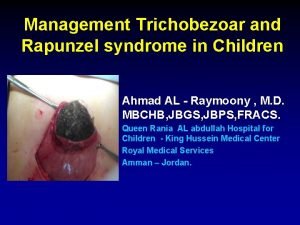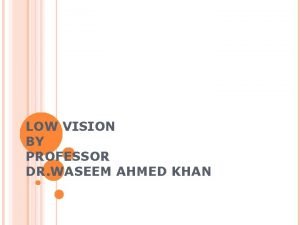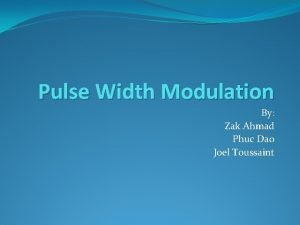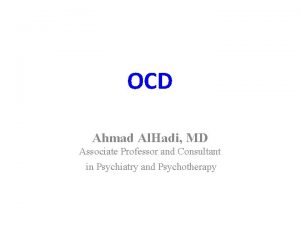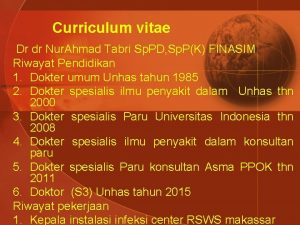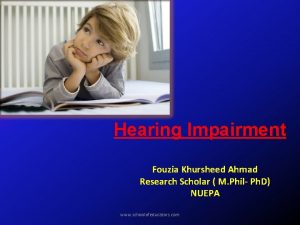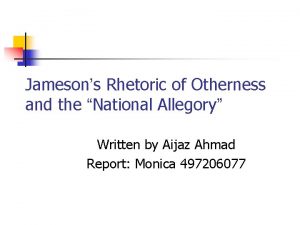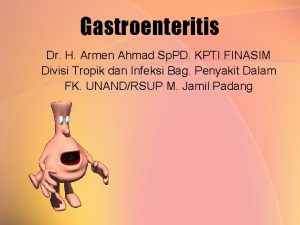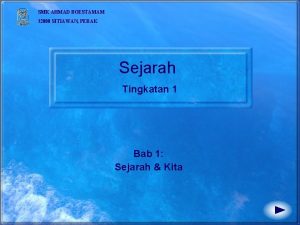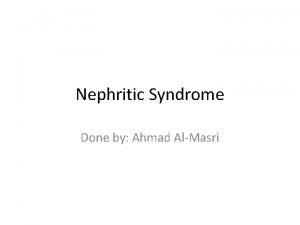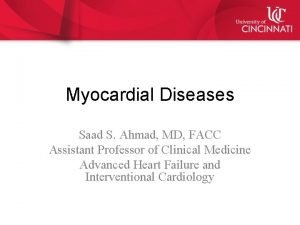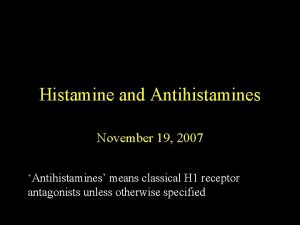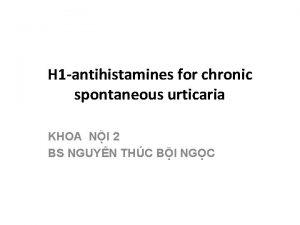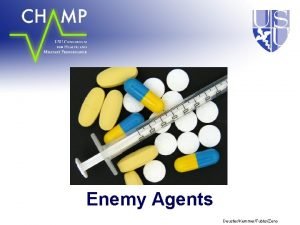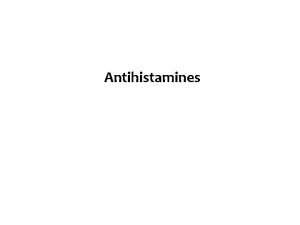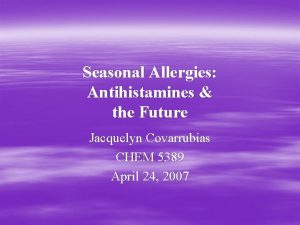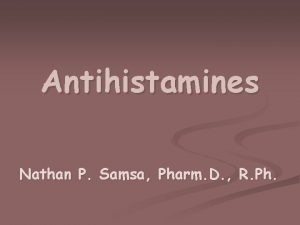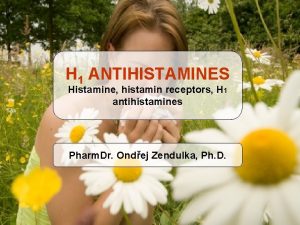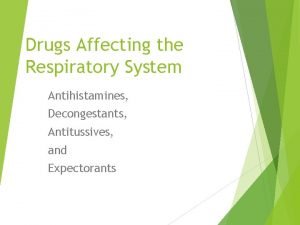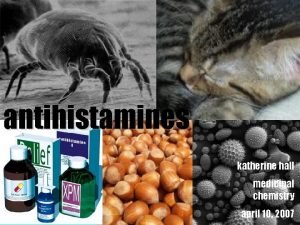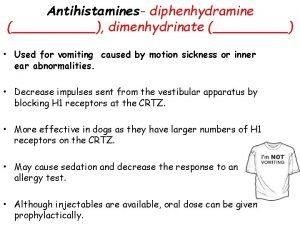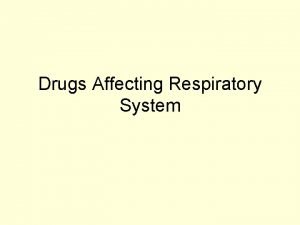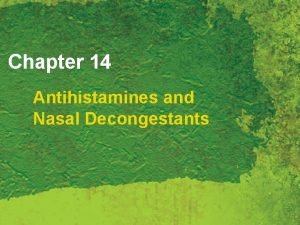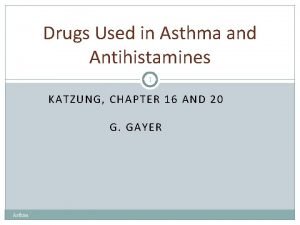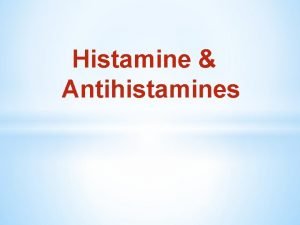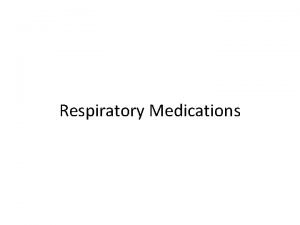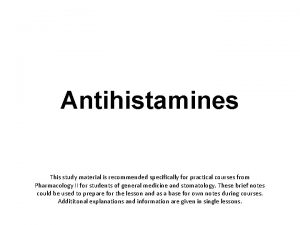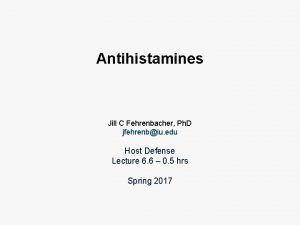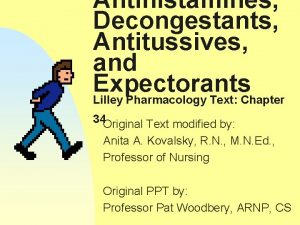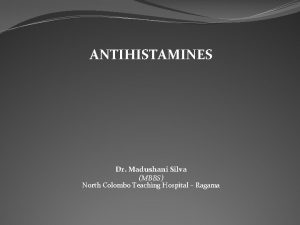H 1 Antihistamines Urticaria Dr M Al Ahmad








































- Slides: 40

H 1 Antihistamines & Urticaria Dr. M. Al. Ahmad , Dermatologist Homs Military Hospital 21. 4. 2009

Histamine is a small molecule derived from the decarboxylation of the amino acid histidine. It is destroyed by the enzyme diamine oxidase (histiminase), which is also involved in the metabolism of other bioactive amines.


Receptor Type Major Tissue Locations Major Biologic Effects H 1 smooth muscle, endothelial cells acute allergic responses H 2 gastric parietal cells secretion of gastric acid H 3 central nervous system modulating neurotransmission H 4 mast cells, eosinophils, T cells, dentritic cells regulating immune responses

Mepyramine The first effective and safe antihistamine. ØWas discovered in 1944 by Parisian investigators , Bovet and walthert. Ø

Classification First- generation H 1 antihistamines. (Sedating-H 1 antihistamines). Ø Second-generation H 1 antihistamines. (None-sedating H 1 antihistamines) Ø

First-generation H 1 antihistamines. Potent effect. ØShort- acting. ØMetabolized in liver by the microsomal cytochrome P-450 system. Ø

First- generation H 1 antihistamines Common side effects: ØSedation. ØAtropine like side effects: -Dryness of the mouth. -Blurring of vision. -Constipation. -Urinary retention. v

v Others: Photosensitivity. ØTachycardia. ØProlongation of the Q-T interval. Ø

Table 1. FDA Approved Indications for First-Generation Antihistamines (7, 8, 9) FDA Approved Age for Use Indications* Pregnancy Category Azatadine (Optimine) > 12 years old PAR, SAR, CU B Azelastine > 3 years old PAR, SAR, VR, AC C Brompheniramine (Dimetane) > 6 years old AR, HR Type 1 c Chlorpheniramine (Chlor-Trimeton) > 2 years old AR B Clemastine (Tavist) > 6 years old PAR, SAR, CU B Cyproheptadine (Periactin) > 2 years old PAR, SAR, CU B Dexchlorpheniramine (Polaramine) > 2 years old PAR, SAR, CU B Can be given < 6 years old Pruritus, Sedation, Analgesia, Anti-emetic C Promethazine (Phenergan) > 2 years old HR Type 1, Sedation, Motion sickness, Analgesia C Tripelennamine (PBZ) > 1 month old PAR, SAR, CU B Drug Name Hydroxyzine (Atarax, Vistaril)

Second generation-H 1 antihistamines No or low sedation when recommended doses are used. ØNo anticholenergic side effects. ØLong- acting. ØNo drug interaction. ØNo cardiac side effects. Ø

Table 2. FDA Approved Indications for Second- and Third-Generation Antihistamines (7, 8) Drug Name Age Restriction Indications* Pregnancy Category Cetirizine (Zyrtec) > 2 years old PAR, SAR, CIU B Fexofenadine (Alle gra) > 6 years old SAR, CIU C Loratadine (Claritin) > 2 years old SAR, CIU B >6 years old PAR, SAR, CIU B > 12 years old PAR, SAR, CIU C Levocetirizine (Xyzal) Desloratadine (Clarinex) *PAR = perennial allergic rhinitis, SAR = seasonal allergic rhinitis, CIU = chronic idiopathic urticaria

Novel second- generation H 1 antihistamines. -Rupatadine. -Bilastine.

H 1 antihistamines in children Second generation ones are probably safer. - Overdose of the fist generation may cause severe toxicity including hyperpyrexia and convulsion. -First-generation ones might cause paradoxical excitation in children. Ø

Indications Hypersensitivity reactions type one: v Perennial or seasonal allergic rhinitis. ØVasomotor rhinitis. ØAllergic conjunctivitis. ØUrticaria. Ø

Urticaria (Hives) Prevalence: (adult and children ): ØAcute : 15 – 25 % lifetime prevalence. ØChronic idiopathic : Up to 5 % of population. 20% of these have symptoms >10 years. v

Acute urticaria -symptoms present for <6 weeks -More common in Young's -More common in atopic vs non atopic

Chronic urticaria - Symptoms continuously or intermittently present for> 6 weeks. -6 weeks is not an absolute demarcation. -Female : 4 : 1 -No increase in incidence in atopics.







Causes Allergic : §Food. -Food additive / preservatives. §Drugs. §Others: (venom, latex… ). v

Infections : v Ø Ø Ø viral parasitic. Questionable : (H-pylori, sinusitis , others )

Non – allergic release of histamines: v Drugs : -Aspirin. - ACE inhibitors. ØNarcotics. ØRadiocntrast media. Ø

Systemic illnesses/ conditions: v Complememt deficiencies. ØCryoglobulinemia Øserum sickness. ØRhumatological. Ø

Idiopathic v Ø More than 50% of cases.

Pharmacological treatment First line : q -Non – sedating H 1 antihistamines. Double the dose if not responding. - Sedating H 1 antihistamines at night.


Results: 12 items · 1. Quality of life in adults with chronic idiopathic urticaria receiving desloratadine: a randomized, double-blind, multicentre, placebo-controlled study. Grob JJ, Auquier P, Dreyfus I, Ortonne JP. J Eur Acad Dermatol Venereol; 2008 Jan ; 22(1): 87 -93. Pub. Med ID: 18181978 [Abstract] [Full Text] [Related] · 2. Increasing the dose of cetirizine may lead to better control of chronic idiopathic urticaria: an open study of 21 patients. Kameyoshi Y, Tanaka T, Mihara S, Takahagi S, Niimi N, Hide M. Br J Dermatol; 2007 Oct ; 157(4): 803 -4. Pub. Med ID: 17627798 [No Abstract] [Full Text] [Related] · 3. The effect of fexofenadine hydrochloride on productivity and quality of life in patients with chronic idiopathic urticaria. Spector SL, Shikiar R, Harding G, Meeves S, Leahy MJ. Cutis; 2007 Feb ; 79(2): 157 -62. Pub. Med ID: 17388220 [Abstract] [Full Text] [Related] · 4. Efficacy and safety of desloratadine in adults with chronic idiopathic urticaria: a randomized, double-blind, placebo-controlled, multicenter trial. Ortonne JP, Grob JJ, Auquier P, Dreyfus I. Am J Clin Dermatol; 2007 ; 8(1): 37 -42. Pub. Med ID: 17298105 [Abstract] [Full Text] [Related] · 5. Levocetirizine is an effective treatment in patients suffering from chronic idiopathic urticaria: a randomized, double-blind, placebo-controlled, parallel, multicenter study. Kapp A, Pichler WJ. Int J Dermatol; 2006 Apr ; 45(4): 469 -74. Pub. Med ID: 16650180 [Abstract] [Full Text] [Related]


THANK YOU






 Urticaria einkenni
Urticaria einkenni Urticaria classification
Urticaria classification Omalizumab urticaria
Omalizumab urticaria Chronic inducible urticaria
Chronic inducible urticaria Angioedema
Angioedema Chronic inducible urticaria
Chronic inducible urticaria Logo smk ahmad pekan
Logo smk ahmad pekan Mian ahmad farhan
Mian ahmad farhan Disadvantages of dsc
Disadvantages of dsc Kausar ahmad
Kausar ahmad Econ 25
Econ 25 Zamri ahmad
Zamri ahmad Nur ahmad husin
Nur ahmad husin Authoritative style of leadership
Authoritative style of leadership Dr shahzad ahmad
Dr shahzad ahmad Dr shahzad ahmad
Dr shahzad ahmad Dr waseem ibrahim
Dr waseem ibrahim Ibrahim primary school
Ibrahim primary school Ahmad gaber
Ahmad gaber Cerpen ibu dan sungai ceper
Cerpen ibu dan sungai ceper What do you mean by duty cycle
What do you mean by duty cycle Ahmad aulia jusuf
Ahmad aulia jusuf Rabiah ahmad
Rabiah ahmad Ahmad rafay alam
Ahmad rafay alam Hadi ahmad md
Hadi ahmad md Ahmad kamal
Ahmad kamal Ahmad israiwa
Ahmad israiwa Dr nur ahmad tabri
Dr nur ahmad tabri Google scholarm
Google scholarm Ahmad aulia jusuf
Ahmad aulia jusuf Aijaz ahmad jameson's rhetoric of otherness summary
Aijaz ahmad jameson's rhetoric of otherness summary Dr armen ahmad
Dr armen ahmad Ahmad albar
Ahmad albar Ahmad boestamam sejarah tingkatan 4
Ahmad boestamam sejarah tingkatan 4 Dr ahmad almasri
Dr ahmad almasri Fawad randhawa
Fawad randhawa Ahmad makki hasan
Ahmad makki hasan Dr mirza ahmad
Dr mirza ahmad Ahmad zahir kite runner
Ahmad zahir kite runner Kussmaul sign
Kussmaul sign Nur ahmad husin
Nur ahmad husin
